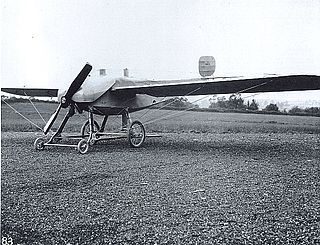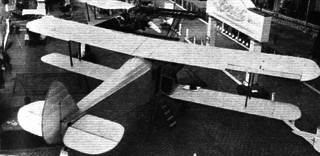Related Research Articles

The Boxkite was the first aircraft produced by the British and Colonial Aeroplane Company. A pusher biplane based on the successful Farman III, it was one of the first aircraft types to be built in quantity. As the type was used by Bristol for instruction purposes at their flying schools at Larkhill and Brooklands many early British aviators learned to fly in a Boxkite. Four were purchased in 1911 by the War Office and examples were sold to Russia and Australia. It continued to be used for training purposes until after the outbreak of the First World War.

The Bristol Scout was a single-seat rotary-engined biplane originally designed as a racing aircraft. Like similar fast, light aircraft of the period it was used by the RNAS and the RFC as a "scout", or fast reconnaissance type. It was one of the first single-seaters to be used as a fighter aircraft, although it was not possible to fit it with an effective forward-firing armament until the first British-designed gun synchronizers became available later in 1916, by which time the Scout was obsolescent. Single-seat fighters continued to be called "scouts" in British usage into the early 1920s.
The Bristol Biplane Type 'T', sometimes called the Challenger-Dickson Biplane, was a derivative of the Bristol Boxkite. It was built in 1911 by the British and Colonial Aeroplane Company and was designed as a cross-country racing aircraft for Maurice Tabuteau.

The Bristol T.B.8, or Bristol-Coanda T.B.8 was an early British biplane built by the Bristol Aeroplane Company and designed by the Romanian Henri Coandă. Fifty four Bristol T.B.8s were built, being mainly used as a trainer. A small number of Bristol T.B.8s were briefly used as bombers at the start of the World War I by the Royal Naval Air Service.

The Bristol Coanda Monoplanes were a series of monoplane trainers designed by the Romanian designer Henri Coandă for the British company British and Colonial Aeroplane Company.

The Bristol Gordon England biplanes were a series of early British military biplane aircraft designed by Gordon England for the Bristol Aeroplane Company that first flew in 1912. Designed for easy ground transport, the aircraft could be quickly disassembled.
The Grahame-White Baby was an early British aircraft designed by pioneer aviator Claude Grahame-White in 1910.
The Sopwith Admiralty Type 807 was a 1910s British biplane seaplane designed and built for the Admiralty by the Sopwith Aviation Company.
The Sopwith Two-Seat Scout was a 1910s British biplane Anti-Zeppelin scout biplane designed and built for the Admiralty by the Sopwith Aviation Company. It was nicknamed the Spinning Jenny due to a tendency to enter a spin.

The Bristol Type 110A was a single-engine biplane for charter work, accommodating four passengers in comfort. Designed by Frank Barnwell and built at Filton Aerodrome by the Bristol Aeroplane Company. No orders were obtained and only one aircraft was built.
The Bristol Type 6 T.T.A was a British two-seat, twin-engine biplane, designed in 1915 as a defence fighter. Two prototypes were built, but the T.T.A. did not go into production.

The Bristol B.R.7 was a Romanian-designed single-engine two-seat biplane built by Bristol to a Spanish government order in 1913. It failed to meet its specifications and the order was cancelled.
The Hydro no.120 was a Romanian-designed two-seat, single-engine biplane configured as a single-float seaplane. Built by Bristol in 1913, it was lost on its first flight.
The Sopwith Three-seater was a British aircraft designed and built prior to the start of the First World War. One of the first aircraft built by the Sopwith Aviation Company, it was operated by both the Royal Naval Air Service (RNAS) and the Royal Flying Corps (RFC), being used briefly over Belgium by the RNAS following the start of the War.

The Short S.41 was a British single-engined biplane built for the Royal Navy in 1912. Capable of being operated either on wheels or floats, it was successful enough for a further two similar aircraft to be built, with the type remaining in use until the early years of the First World War.

The Dunne D.8 of 1912 was a tailless swept wing biplane, designed by J. W. Dunne to have inherent stability. One example was supplied to RAE Farnborough. License-built Burgess-Dunne models were used by the US Signal Corps and United States Navy and the short-lived Canadian Aviation Corps. It was the latter's first and only warplane.

The Short S.27 and its derivative, the Short Improved S.27, were a series of early British aircraft built by Short Brothers. They were used by the Admiralty and Naval Wing of the Royal Flying Corps for training the Royal Navy's first pilots as well as for early naval aviation experiments. An Improved S.27 was used by C.R. Samson to make the first successful take-off from a moving ship on 9 May 1912.

The COW Biplane was a British tractor biplane built to compete in the 1912 British Military Aeroplane Competition. It was not successful.
The Bristol Racing Biplane was a British single-seat biplane designed to combine the performance of a monoplane but using the strength of the biplane. It was designed by Robert Grandseigne and Léon Versepuy, who were supervised by George Challenger for the British & Colonial Aeroplane Company of Bristol, it crashed on its first flight.

The Short S.36 was a British two-seat tractor biplane, built by Short Brothers for Francis McClean in 1911. It was later developed into the Short S.41 and Short S.45, which were the first of a long series of similar aircraft built for the RNAS and RFC.
References
- Barnes, Chris (1988). Bristol Aircraft since 1910. London: Putnam. ISBN 0-85177-823-2.